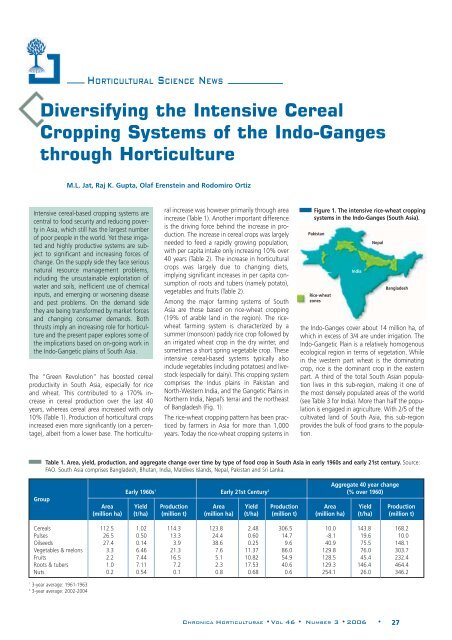Acta Horticulturae
Acta Horticulturae
Acta Horticulturae
Create successful ePaper yourself
Turn your PDF publications into a flip-book with our unique Google optimized e-Paper software.
HORTICULTURAL SCIENCE NEWS<br />
Diversifying the Intensive Cereal<br />
Cropping Systems of the Indo-Ganges<br />
through Horticulture<br />
M.L. Jat, Raj K. Gupta, Olaf Erenstein and Rodomiro Ortiz<br />
Intensive cereal-based cropping systems are<br />
central to food security and reducing poverty<br />
in Asia, which still has the largest number<br />
of poor people in the world. Yet these irrigated<br />
and highly productive systems are subject<br />
to significant and increasing forces of<br />
change. On the supply side they face serious<br />
natural resource management problems,<br />
including the unsustainable exploitation of<br />
water and soils, inefficient use of chemical<br />
inputs, and emerging or worsening disease<br />
and pest problems. On the demand side<br />
they are being transformed by market forces<br />
and changing consumer demands. Both<br />
thrusts imply an increasing role for horticulture<br />
and the present paper explores some of<br />
the implications based on on-going work in<br />
the Indo-Gangetic plains of South Asia.<br />
The “Green Revolution” has boosted cereal<br />
productivity in South Asia, especially for rice<br />
and wheat. This contributed to a 170% increase<br />
in cereal production over the last 40<br />
years, whereas cereal area increased with only<br />
10% (Table 1). Production of horticultural crops<br />
increased even more significantly (on a percentage),<br />
albeit from a lower base. The horticultu-<br />
ral increase was however primarily through area<br />
increase (Table 1). Another important difference<br />
is the driving force behind the increase in production.<br />
The increase in cereal crops was largely<br />
needed to feed a rapidly growing population,<br />
with per capita intake only increasing 10% over<br />
40 years (Table 2). The increase in horticultural<br />
crops was largely due to changing diets,<br />
implying significant increases in per capita consumption<br />
of roots and tubers (namely potato),<br />
vegetables and fruits (Table 2).<br />
Among the major farming systems of South<br />
Asia are those based on rice-wheat cropping<br />
(19% of arable land in the region). The ricewheat<br />
farming system is characterized by a<br />
summer (monsoon) paddy rice crop followed by<br />
an irrigated wheat crop in the dry winter, and<br />
sometimes a short spring vegetable crop. These<br />
intensive cereal-based systems typically also<br />
include vegetables (including potatoes) and livestock<br />
(especially for dairy). This cropping system<br />
comprises the Indus plains in Pakistan and<br />
North-Western India, and the Gangetic Plains in<br />
Northern India, Nepal’s terrai and the northeast<br />
of Bangladesh (Fig. 1).<br />
The rice-wheat cropping pattern has been practiced<br />
by farmers in Asia for more than 1,000<br />
years. Today the rice-wheat cropping systems in<br />
Figure 1. The intensive rice-wheat cropping<br />
systems in the Indo-Ganges (South Asia).<br />
Pakistan<br />
Rice-wheat<br />
zones<br />
India<br />
Nepal<br />
Bangladesh<br />
the Indo-Ganges cover about 14 million ha, of<br />
which in excess of 3/4 are under irrigation. The<br />
Indo-Gangetic Plain is a relatively homogenous<br />
ecological region in terms of vegetation. While<br />
in the western part wheat is the dominating<br />
crop, rice is the dominant crop in the eastern<br />
part. A third of the total South Asian population<br />
lives in this sub-region, making it one of<br />
the most densely populated areas of the world<br />
(see Table 3 for India). More than half the population<br />
is engaged in agriculture. With 2/5 of the<br />
cultivated land of South Asia, this sub-region<br />
provides the bulk of food grains to the population.<br />
Table 1. Area, yield, production, and aggregate change over time by type of food crop in South Asia in early 1960s and early 21st century. Source:<br />
FAO. South Asia comprises Bangladesh, Bhutan, India, Maldives Islands, Nepal, Pakistan and Sri Lanka.<br />
Group<br />
Aggregate 40 year change<br />
Early 1960s 1 Early 21st Century 2 (% over 1960)<br />
Area Yield Production Area Yield Production Area Yield Production<br />
(million ha) (t/ha) (million t) (million ha) (t/ha) (million t) (million ha) (t/ha) (million t)<br />
Cereals 112.5 1.02 114.3 123.8 2.48 306.5 10.0 143.8 168.2<br />
Pulses 26.5 0.50 13.3 24.4 0.60 14.7 -8.1 19.6 10.0<br />
Oilseeds 27.4 0.14 3.9 38.6 0.25 9.6 40.9 75.5 148.1<br />
Vegetables & melons 3.3 6.46 21.3 7.6 11.37 86.0 129.8 76.0 303.7<br />
Fruits 2.2 7.44 16.5 5.1 10.82 54.9 128.5 45.4 232.4<br />
Roots & tubers 1.0 7.11 7.2 2.3 17.53 40.6 129.3 146.4 464.4<br />
Nuts 0.2 0.54 0.1 0.8 0.68 0.6 254.1 26.0 346.2<br />
1<br />
3-year average: 1961-1963<br />
2<br />
3-year average: 2002-2004<br />
CHRONICA HORTICULTURAE •VOL 46 • NUMBER 3 • 2006 • 27
















